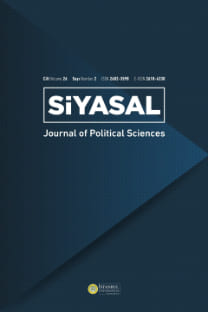TÜRKİYE’DE DÖVİZ KURU KANALININ İŞLEYİŞİ: VAR MODELİ İLE BİR ANALİZ
Öz
Para politikası kararlarındaki değişikliklerin reel değişkenlerin yanı sıra fiyat seviyesini
etkileme süreci, parasal aktarım kavramı ile ifade edilir. Faiz oranı kanalı, varlık fiyatları
kanalı, döviz kuru kanalı, kredi kanalı ve beklenti kanalı başlıca aktarım kanallarıdır.
Uluslararası entegrasyon ve ekonomilerin dışa açıklık derecelerinin artması döviz kuru
kanalının önemini göreli olarak artırmıştır. Açık ekonomilerde para politikası kararlarındaki
bir değişiklik, döviz kuru kanalı ile hem hasıla hem de fiyat seviyesini etkilemektedir.
Bu çalışmada döviz kuru kanalının işleyişi Türkiye özelinde incelenmektedir. Bu amaçla
1995:1 – 2006:12 dönemine ilişkin aylık veriler VAR metodolojisi ile test edilmiştir. Elde
edilen bulgulara göre, Türkiye’de döviz kuru kanalı işlemektedir.
Anahtar Kelimeler:
Parasal Aktarım Kanalları, Döviz Kuru Kanalı, VAR Modeli, Para Politikası
___
AHN, Byung Chan (1994), “Monetary Policy and the Determination of the Interest Rate and Exchange Rate in a Small Open Economy with Increasing Capital Mobility”, Federal Reserve Bank of St.Louis Working Paper, 1994 – 024A, 1-27.• ANDRES, Javier, MESTRE, R. ve VALLE, J. (1999), “Monatery Policy and Exchange Rate Dynamics in The Spanish Economy”, Span. Econ. Rev, 1, 55-77.
• BERNANKE, Ben S., BLINDER, A. S. (1992), “The Federal Funds Rate and the Channels of Monetary Transmission”, The American Economic Review, 82, (4), 901-921.
• BOUGHARA, Adel (2003), “What Do We Know About Monetary Policy and Transmission Mechanism in in Morrocco and Tunisia?” , The 10th Annual Conference of the Economic Research Forum (ERF), in Marrakech - Morocco , 18-21 December, 1-30.
• CAMARERO,M., J. Ordónez ve TAMARIT, C.R. (2002), “Monetary Transmission in Spain: a Structural Cintegrated VAR Approach”, Applied Economics, 34, 2201-2212.
• CORICELLI, Fabrizio, EGERT, B. ve MACDONALD, R. (2005), “Monetary Transmission Mechanism in Central and Eastern Europe: Surveying the Empirical Evidence”, Finance and Consumption Programme, 1-52.
• CHOW, Gregory C. (1960), "Tests of Equality between Sets of Coefficients in Two Linear Regressions", Econometrica, 28, 591-605.
• DICKEY, David A. ve PANTULA, S. G. (1987), “Determining the Order of Differencing in Autoregressive Processes”, Journal of Business & Economic Statistics, 5, (4), 455-461.
• DICKEY, David A., ve FULLER, W. A. (1979), “Distribution of the Estimators for Autoregressive Time Series with a Unit Root”, Journal of the American Statistical Association, 74, 427 – 431.
• DICKEY, David A., ve FULLER, W. A. (1981), Likelihood Ratio Statistics for Autoregressive Time Series with a Unit Root”, Econometrica, 49, (4), 1057-1072.
• ENDERS, Walter, Applied Econometric Time Series, United States of America: John Wiley&Sons, Inc., 1995.
• GRANGER, C.W.J., ve NEWBOLD, P. (1974), “Spurious Regressions in Econometrics”, Journal of Econometrics, 2 (2), 1974, 111- 120.
• GRUEN, David, Discussion, Reserve Bank Of Australia 1997 Conference- Monetary Policy and Inflation Targeting, 21-22 July, 1997, 238 -243.
• GÜNDÜZ, Lokman (2001), “Türkiye’de Parasal Aktarım Mekanizması ve Banka Kredileri Kanalı”, İMKB Dergisi, Cilt:5 Sayı:18, 13-30
HORNGREN, Lars (1995), “Monetary Policy in Theory and Practice”, Quarterly Review, 3, 1 – 12.
• IRELAND, Peter N. (2005), “The Monetary Transmission Mechanism”, Federal Reserve Bank of Boston Working Paper, No:06 – 1, 1 - 13.
• JAMES, H. Stock and WATSON, M. W. (2001, “Forecasting Output and Inflation: The Role of Asset Prices”, Journal of Economic Literature, 41, (3), 788-829.
• KALKAN, M., KIPICI, A. N. ve PEKER, A. T. (1997), “Leading Indicators of Inflation in Turkey”, IFC Bulletin, Nr. 1,71-92.
• KAMIN, Steven, TURNER, P. ve VAN’T DACK, J. (1998), “The Transmission Mechanism of Monetary Policy in Emerging Market Economies: An Overview”, BIS, Policy Paper, No:3, 5 -65.
• KASAPOĞLU, Özgür (2007), Parasal Aktarım Mekanizmaları: Türkiye İçin Uygulama, Uzmanlık Yeterlilik Tezi, Türkiye Cumhuriyet Merkez Bankası, Piyasalar Genel Müdürlüğü.
• MISHKIN, F. S. (1995), “Symposium on Monetary Transmission Mechanism”, The Journal of Economic Perspectives, 9, (4), 3-10.
• MISHKIN, F. S. (1996), “The Channels of Monetary Transmission: Lessons For Monetary Policy”, NBER Working, Paper, No:5464, 1 -27.
• MISHKIN, F. S. (2001), “The Transmission Mechanism and The Role of Asset Princes in Monetary Policy”, NBER Working Paper, No: 8617, 1 -21.
• NAGAYASU, Jun (2007), “Empirical Analysis of the Exchange Rate Channel in Japan”, Journal of International Money and Finance, 26, (6), 887-904.
• NELSON, Charles R., PLOSSER, C. I. (1982), “Trends and Random Walks in Macroeconomic Time Series Some Evidence and Implications”, Journal of Monetary Economics, 10, (2), 139-162.
• NORBBIN, Stefan (2000), “What Have We Learned from Empirical Tests of The Monetary Transmission Effect?”, Florida State University, Department of Economics, 1 -40.
• PEERSMAN, Gert (2001), The Transmission of Monetary Policy in the Euro Area: Implications for the European Central Bank, Universiteit Gent, Department of Economics and Business Administration, Dissertation Ph.D.
• PAGAN, A. R. ve ROBERTSON, J. C. (1998), "Structural Models of the Liquidity Effect", The Review of Economics and Statistics, 80, (2), 202- 217.
• PODDAR, Tushar, SAB, R. ve KHACHATRYAN, H. (2006), “The Monetary Transmission Mechanism in Jordan”, IMF Working Paper, WP/06/48, 1 – 26.
• HOOPER, Peter ve KOHLHAGEN, S. W. (1978), “The effect of exchange rate uncertainty on the prices and volume of international trade”, Journal of International Economics, 8, 483-511.
SMETS, Frank ve WOUTERS, R. (1999), “The Exchange Rate and the Monetary Transmission Mechanism in Germany”, De Economist, 147, (4), 489 – 521.
• SIMS, C. (1980), "Macroeconomics and Reality", Econometrica, 48, 1-49.
• WİCKENS, Michael R. ve MOTTO, R. (2001), “Estimating Shocks and Impulse Response Functions”, Journal of Applied Econometrics, 16, (3), 371-387. • http://www.tcmb.gov.tr/
- ISSN: 1303-1260
- Yayın Aralığı: Yılda 2 Sayı
- Yayıncı: İstanbul Üniversitesi
Sayıdaki Diğer Makaleler
PHİLLİPS EĞRİSİ: YARIM YÜZYILDIR BİTMEYEN TARTIŞMA
KÜRESEL İKLİM DEĞİŞİKLİĞİ SÜRECİNDE SU YÖNETİMİ
Para Politikalarının Banka Kredi Kanalı Üzerindeki Etkileri
Nejla AKLAN, Mehmet NARGELEÇEKENLER
TÜRKİYE’DE DÖVİZ KURU KANALININ İŞLEYİŞİ: VAR MODELİ İLE BİR ANALİZ
Seyfettin ERDOĞAN, Durmuş YILDIRIM
Ortadoğu'da Kadın Hareketleri: Farklı Yollar, Farklı Stratejiler
TÜRKİYE’DE BELEDİYELERİN BORÇLANMA SÜRECİ: 1960-2006
ORTADOĞU SİYASETİ VE TOPLUMLARINI ANLAMA YOLLARI
Değer Temelli Pazarlama Anlayışında Balanced Scorecard'ın Stratejik Önemi
Suriye Arap Milliyetçiliğinde Vatan ve Suriyelilik (1919-1939)
Dünya Bankası ve IMF Kapsamında Uluslararası Finans Kuruluşları ve İnsan Hakları
